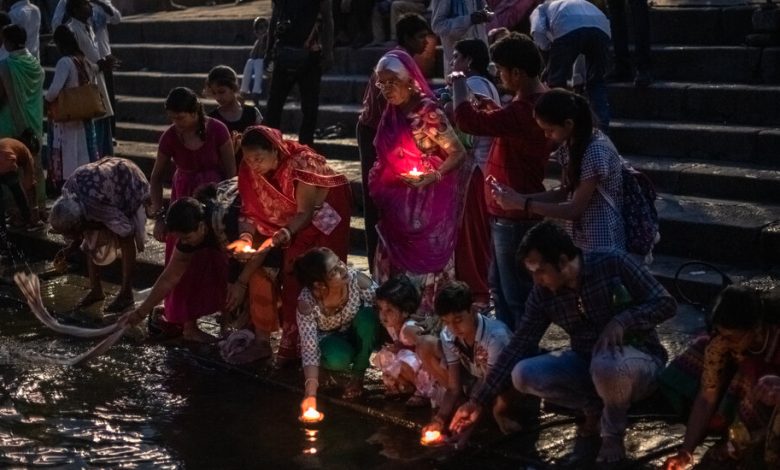Is That All There Is? A Secular Seeker Visits Holy Sites.

THE HALF KNOWN LIFE: In Search of Paradise, by Pico Iyer
Ten times over 12 years, Pico Iyer accompanied the Dalai Lama across Japan. Inevitably, at every large public gathering, someone would ask what to do after having been disappointed by a dream not realized. The dreams themselves differed — peace in the Middle East, a reversal of climate change or hope for a relationship — but the disillusionment was always the same.
“Wrong dream!” the Dalai Lama would respond.
“The Half Known Life,” with this vignette at its center,takes the Dalai Lama’s sentiment to heart. How to reconcile our wishes and hopes with reality? Where does paradise really lie? What can a secular seeker learn from the world’s holiest places? In Iyer’s hands, the search for paradise, the way out of the ego, doubles as an internal journey. Skittering from the gardens of Iran’s holiest mosques to the car-free streets of North Korea’s capital, from the avenues of East Belfast to war-torn Kashmir’s Dal Lake houseboats, from the outback of aboriginal Australia to the Ethiopian chapels of Jerusalem, from the empty moonscape of Ladakh to the massive stone Buddhas of Sri Lanka, from the graveyards of Japan’s mountain temples to the burning ghats of Varanasi, this elliptical odyssey, graced with occasional notes of light, finds itself by dwelling in the shadows. The places we avoid, Iyer says, are “so often closer to us than the ones we eagerly seek out.”
No stranger to the travel genre, the prolific Iyer is after something more here. His chronicle, which begins with an appreciation of the sophistication, beauty and culture of Iran, becomes a requiem for a world — and an existence — estranged from itself. There are only two things he is afraid of, he tells us: serpents and heights; and there are plenty of both here, along with crypts, tombstones, graveyards, burning corpses and flickering lights, “an infinity of reflections” in “a treasure house of riddles.” A lonely, nostalgic and haunted quality emerges as Iyer casually intersperses bits of his personal history. There is a formula to many of the chapters: He touches down in a new place, checks into a lodging and finds a taxi or guide to take him to the next site. We meet his drivers, listen to their surprising conversation and extract unexpected wisdom. “The writer’s job,” Iyer opines, “is to dismantle the very notion of Other by showing how your hurts belong to me, as my hopes do to you.” But empathy is not the only thing going on; Iyer is also looking within. And as he looks, things get dizzier and dizzier.
Iyer is not a Buddhist, but he has a Buddhist sensibility. Born in Oxford and educated in elite English boarding schools, he is a secular writer with an eye for the spiritual. His book has the soft ring of a classic Buddhist meditation strategy: In order to understand the emptiness of the ego, one must first find the self as it appears. This might sound easy, but in practice it is incredibly frustrating. The more one tries to zero in on the self, the more elusive it becomes. The process is often likened to a dog chasing its own tail — round and round you go until the very giddiness of the process whirls you into an unexpected understanding. “The Half Known Life”brings this uncertainty to the fore. By the end of the book, Iyer wakes to a fog-drenched Varanasi, the holy Indian city of the dead. He can barely see 30 feet in front of him. Fires from burning bodies add smoke to the mist. We are in a “half known realm” filled with “ghostly towers and palaces” where the only paradise is a “candlelit back alleyway” that shows the way home. Iyer references Emily Dickinson and Herman Melville as he gathers his conclusions; both writers inferred that “a keen sense of all that could never be fathomed” is the way to paradise.
For Iyer, this thing that could never be fathomed — the self, the past, one’s ancestors, the world — is also, first and foremost, death. It is everywhere in this book. Our lives are only half known, he concludes, because we can never tell what the final act will be. And we will be unable to reflect upon it after it occurs. “The fact that nothing lasts is the reason why everything matters,” he realizes while in the Japanese monastery of Koyasan. But it is in Varanasi that he brings it all together. As an Englishman with relatives in India, he had always avoided Varanasi. “Too dirty,” they had warned him. But it is there that he makes a critical connection. “Death is not the opposite of life,” he writes, quoting the Varanasi scholar Diana Eck. It is, rather, “the opposite of birth.”
Iyer probably knows, and would appreciate, the ancient Buddhist sutra “The Questions of King Milinda.” It is a discussion probing the nature of the self between the Greek king of Bactria (in present-day Afghanistan), a contemporary of Alexander the Great, and a Buddhist sage named Nagasena, an early example of the crossing of cultures so prominent in Iyer’s oeuvre. King Milinda wonders aloud if the self is permanent or impermanent. “Is the fruit of the mango tree in your garden sweet or sour?” counters Nagasena. “There is no mango tree in my garden,” Milinda replies. “Exactly,” says Nagasena.
Wrong dream, as the Dalai Lama suggested to his Japanese followers.
Mark Epstein is a psychiatrist in New York City. His latest book is “The Zen of Therapy: Uncovering a Hidden Kindness in Life.”
THE HALF KNOWN LIFE: In Search of Paradise | By Pico Iyer | 226 pp. | Riverhead | $26
